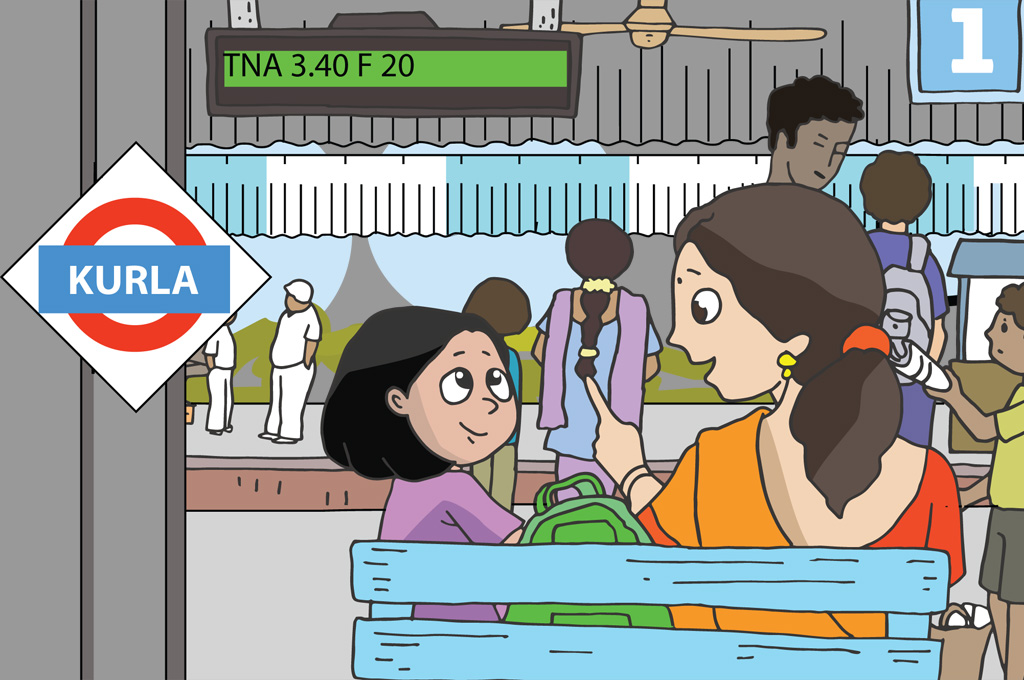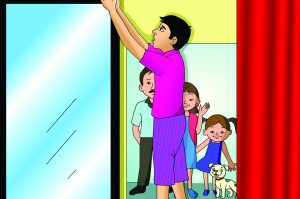Eight-year-old Riya was going to stay with her aunt, Anita for the summer holidays. While Riya stayed at Kurla, a residential area in Mumbai, her aunt lived in Thane, a district neighbouring Mumbai.
Aunt Anita had come to take Riya to her house. Riya was excited and had packed her bags well in advance. As they walked, Riya asked, Will we be taking the bus to your house, Aunt Anita?”
“No. The bus usually takes too long.
We’ll take the suburban train,” replied Aunt Anita.
“What’s a suburban train?” asked Riya.
“Unlike trains that connect one city to another, the suburban trains connect all the important locations within a city. They also connect the towns on the outskirts from where many people travel to the city on a daily basis,” explained Aunt Anita.
“This is going to be my first time travelling in a suburban train!” said Riya excitedly.
“In that case, let me explain everything about the suburban train system as we go,” said Aunt Anita. “But first, we need to buy the ticket.”
As soon as they reached the Kurla suburban railway station, Aunt Anita and Riya stood in a queue at the ticket counter.
“This is where we have to buy the tickets. However, there are also vending machines from which you can buy tickets faster. Passengers who travel regularly can buy a season ticket, which is valid for a long period like one or three months,” said Aunt Anita.
After purchasing the tickets, Aunt Anita said, “We can now board any train that will take us to Thane. There are fast trains with fewer stops or slow trains that stop at every station and take longer. Once we decide which train to take, we’ll need to check the board and find out which platform we need to go to.”
Riya and Aunt Anita climbed the stairs leading to the platform.
“Aunt Anita, when was the first suburban train service started?” asked Riya.
“The first local train service was started by the British in the year 1653 from the Chattrapati Shivaji Terminus in South Mumbai to Thane,” said Aunt Anita.
After reaching the platform, the two found an empty bench and sat down. There was still some time for the train to arrive.
Aunt Anita pointed to an electronic display board and said, “Look up there. That board shows which train is coming next and where it is headed to.”
Riya looked at the board. The train to Thane was due to arrive at the platform.
Aunt Anita started telling Riya about the different train routes in Mumbai. “Mumbai has four train routes: Western line connects the western suburbs or residential areas; Harbour line connects the suburbs of Navi Mumbai to the central areas of Mumbai; Central line connects the areas within the centre of the city; the Trans Harbour line connects the suburbs between Thane and Panvel.”
Riya then looked around the train station. She noticed a cobbler shining a customer’s shoes, a vendor selling peanuts and several stalls selling food and magazines.
Soon their train arrived at the platform. Riya and Aunt Anita stepped onto the train and found a seat by the window.
“Being a weekday afternoon, the train is quite empty today. Good for us,” said Aunt Anita.
“Why were some people running to board a different compartment?” asked Riya.
“That is because there are different compartments in the train: the First Class compartments have tickets that are more expensive than the other compartments; Second Class compartments have relatively cheaper tickets; Ladies compartments are specifically reserved for women; and there’s one for the physically challenged, cancer patients and senior citizens for them to travel safely,” explained Aunt Anita.
“I also saw a couple of boys climbing onto the train’s rooftop. Why were they doing that?” asked Riya.
“It is against the law to travel on the roof of the train. But some do it to avoid getting caught for travelling without a ticket and some do it for fun. This is dangerous. You might also see some people hanging out of the train and waving their hands. That is very unsafe,” said Aunt Anita.
“Our train is so dirty!” said Riya, looking around the compartment.
“Yes, it is. But we are responsiblefor this dirt. Over 70 lakh people commute by local trains every day. It is we who litter the trains. Some passengers even chew paan and spit inside the compartment. We should be more responsible and stop dirtying our trains,” said Aunt Anita.
After an hour, the train reached Thane station. Riya and Aunt Anita got off the train.
“My first local train journey was so much fun. I got to learn so many things. Thank you, Aunt Anita!” said Riya, happily.
Aunt Anita smiled and said, “I am glad you enjoyed your train journey. Mumbai’s train services are constantly changing. So, in a few years’ time, the trains and the stations could be very different from what you see today. The government is introducing free Wi-Fi in the stations and installing escalators too. There are also plans to have air-conditioned compartments. This will greatly improve the experience of travelling in a train.”
Riya agreed. She could not wait to tell her friends about her experience of travelling in a local train.














What is moral
Bravo